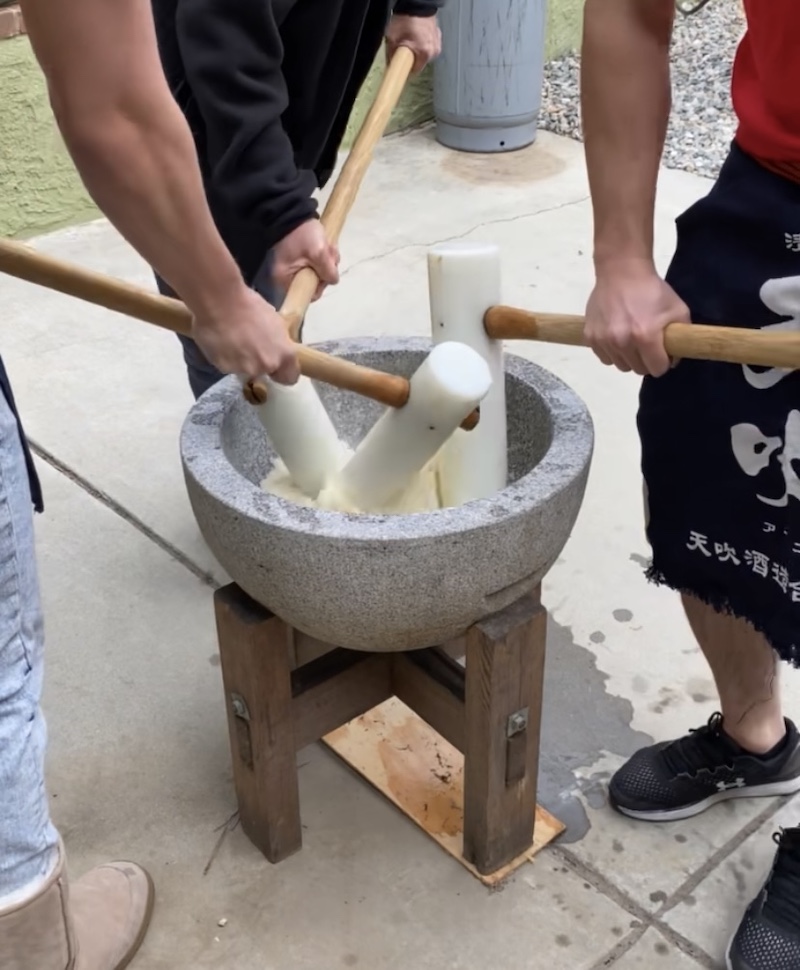Mochitsuki: My Holiday Tradition

Kiyoko Nakatsui
Education Coordinator
Sticky, chewy, delicious! Mochi is an iconic and beloved food of Japan. There is a simplicity and beauty in one ingredient creating something so delicious. This simple food is one of the first things that come to mind when I think of the holiday season. When you think of Christmas, most people imagine opening presents, Christmas trees, stockings, and enjoying this time together. I think of getting up early to go to my auntie and uncle’s house to make mochi with our extended family and friends for the new year.
The origin of rice cakes can be traced back thousands of years to China and were believed to have been introduced to Japan a couple hundred years later. Mochi, as it is known in Japan, proliferated through the culture over the next millennium. It is now extremely popular worldwide and a staple during the holidays, especially for New Years. Between Christmas and New Years people all over Japan take part in a tradition, known as mochitsuki, where rice is pounded into mochi.
It’s early Christmas morning, there’s still a chill in the air from the night before as we pull into the driveway of the nursery where my auntie and uncle work and live. There are already so many people running around and I know preparations started the night before. Luckily, my mom has a very big family, so there are many hands to help make the hundreds of pounds of mochi we make every year. We always make enough for everyone who attends, but also enough to share with friends and other family members.
To make the mochi we soak a special rice, mochigome, overnight before we steam it in the morning. This is a special short grain, high gluten, sticky variety of Japanese rice used almost exclusively for this application. Once the rice is steamed all the fun begins and anyone of able body is called over to start the process of turning the rice into delicious mochi.
We take the rice and put it in an usu. An usu looks like a large mortar, is traditionally made of stone or wood, and is the vessel that holds the rice as it is pounded. My family has two large granite usu and plenty of wood and plastic mallets for everyone to pound together. Since we need to make so much mochi we also use a large mochi making machine. For this machine you just dump the steamed rice inside and let it run. Now this is so much easier, so you may be wondering why we don’t just buy a few more of these machines and call it a day. Well, that’s because the machine can never replicate the taste, texture, and experience of pounding mochi yourself.
We not only pound the mochi ourselves because it tastes better, but also because pounding mochi and consuming it are said to bring good luck for the new year. Once the mochi is the right consistency we all line up at a huge table and work together to create different types of mochi. Some will be plain, some filled with sweet red bean (ahnko), some flavored with mugwort (yomogi), and some filled and flavored. However, the most important mochi we make are the kagamimochi, which are a large and small mochi stacked on top of each other topped with a mandarin orange. This mochi is displayed in the house and eaten for good luck in the middle of January.
Making mochi isn’t an easy process. It requires a lot of time, energy, effort, and would be much easier to just buy at the store. With all that being said, this is a tradition that I plan to never let die in my family. It is a tradition and experience that is deeply rooted in our Japanese heritage and something I take a lot of pride in doing every year.
At the garden I am happy that we are growing yomogi and that I am able to share my stories of making yomogi mochi with my family with our guests. Although mochitsuki is a winter tradition, mochi is enjoyed year round all over Japan and has so many traditional and new iterations for people to try. If you’d like to learn more about traditional Japanese foods eaten during the winter, please come to our A Bounty of Seasons: Fuyu cooking demonstration on Wednesday, January 18th at 10:30am.


